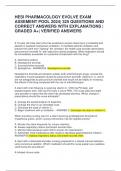Tentamen (uitwerkingen)
HESI PHARMACOLOGY EVOLVE EXAM ASSEMENT POOL 2024| 325 QUESTIONS AND CORRECT ANSWERS WITH EXPLANATIONS | GRADED A+| VERIFIED ANSWERS
- Vak
- Instelling
HESI PHARMACOLOGY EVOLVE EXAM ASSEMENT POOL 2024| 325 QUESTIONS AND CORRECT ANSWERS WITH EXPLANATIONS | GRADED A+| VERIFIED ANSWERS
[Meer zien]



